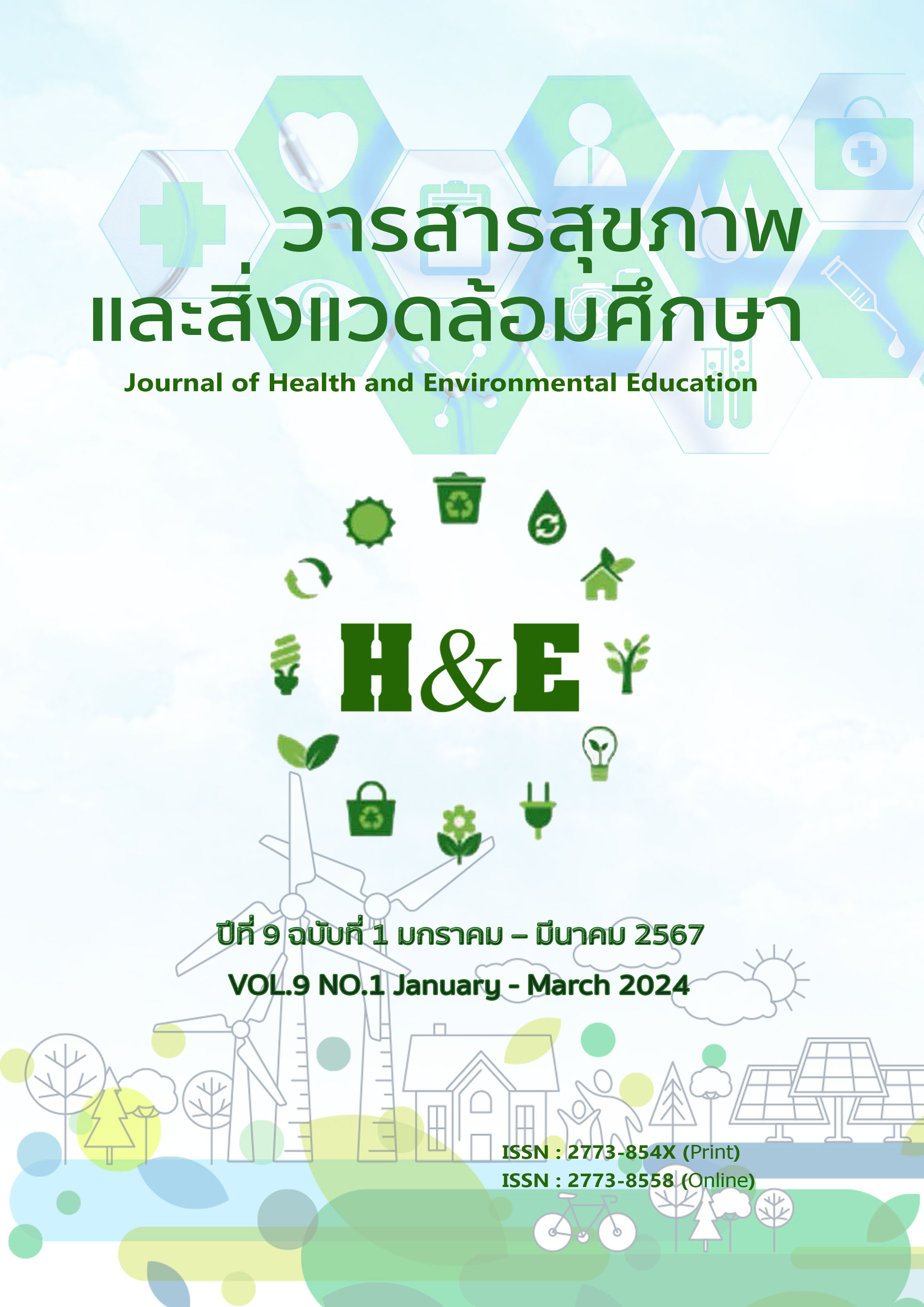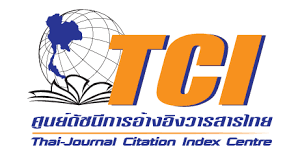Survival proportion and prognostic factor after damage control laparotomy in blunt abdominal injured patients
Keywords:
Damage control laparotomy, Blunt abdominal injured, Survival rateAbstract
This study aims to investigate survival proportion and factors that influence survival in patients who had blunt abdominal injury and received damage control laparotomy at Udonthani Hospital. The study used retrospective data of patients from Udon Thani Hospital who suffered severe abdominal injuries between January 1, 2018 and December 31, 2022. The research tool comprised two parts: 1) patient’s demographic data and 2) clinical data. For patient characteristics and survival rates, descriptive statistics was employed. Logistic regression was used to investigate risk factors that influence survival rates.
The results of 64 patients who underwent damage control laparotomy revealed a survival percentage of 76.56%, predominantly among males (78.13%), those under the age of 55 (76.56%), and victims of traffic accidents (87.50%). The results showed that patients who had 2 or more injured organs in the abdominal cavity accounted for 71.81%. The internal abdominal organs that were the primary causes of bleeding were the liver (57.81%), followed by the mesentery (15.63%), and the spleen (12.50%). The most prevalent surgical technique in first operation was abdominal packing (93.75%), followed by Hepatorrhaphy (18.75%) and bowel repair (15.62%).Blood loss (AOR=9.61, 95% CI=1.62-56.95), blunt abdominal injuries with severe brain injury (AOR=40.89, 95% CI=2.12-786.85), and serum bicarbonate level (AOR=10.00, 95%CI=1.65-60.51) were discovered as significant factors affecting survival rates in the study.
References
J. A. Morris, Jr., V. A. Eddy, E. J. Rutherford. The trauma celiotomy: the evolving concepts of damage control. Curr Probl Surg 1996;33(8):611-700.
Rattanachai Pipatvilikul, Amonpon Kanlerd. Trauma-induced coagulopathy. Journal of the Association of General Surgeons of Thailand under the Royal of Patronage of HM the King. 2022;7(1).
D. J. Roberts, N. Bobrovitz, D. A. Zygun, A. W. Kirkpatrick, C. G. Ball, P. D. Faris, et al. Evidence for use of damage control surgery and damage control interventions in civilian trauma patients: a systematic review. World J Emerg Surg 2021;16(1):10.
M. L. Walker. The damage control laparotomy. Journal of the National Medical Association. 1995;87(2):119-22.
Mark R Hemmila, Wendy L Wahl. Management of the injured patient. J Current Surgical Diagnosis Treatment. 2008:227-8.
Atichart Chompookum. Good prognostic factors of operated blunt abdominal injured patients in Mahasarakham hospital. Mahasarakham Hospital Journal. 2020;17(3):199-209.
L. Leonardi, M. K. Fonseca, N. Baldissera, Cebd Cunha, Y. T. M. Petrillo, R. R. Dalcin, et al. Predictive factors of mortality in damage control surgery for abdominal trauma. Revista do Colegio Brasileiro de Cirurgioes. 2022;49:e20223390.
S. K. Pimentel, G. V. Sawczyn, M. M. Mazepa, F. G. da Rosa, A. Nars, I. A. Collaço. Risk factors for mortality in blunt abdominal trauma with surgical approach. Revista do Colegio Brasileiro de Cirurgioes. 2015;42(4):259-64.
M. Hommes, S. Chowdhury, D. Visconti, P. H. Navsaria, J. E. J. Krige, D. Cadosch, et al. Contemporary damage control surgery outcomes: 80 patients with severe abdominal injuries in the right upper quadrant analyzed. Eur J Trauma Emerg Surg. 2018;44(1):79-85.
N. Rajkumari, K. Sharma, P. Mathu, S. Kumar, A. Gupta. A study on surgical site infections after trauma surgeries in a tertiary care hospital in north India. Indian J Med Res. 2014;140(5):691-4.
H. H. Stone, P. R. Strom, R. J. Mullins. Management of the major coagulopathy with onset during laparotomy. Ann Surg. 1983;197(5):532-5.
M. A. Gad, A. Saber, S. Farrag, M. E. Shams, G. M. Ellabban. Incidence, patterns, and factors predicting mortality of abdominal injuries in trauma patients. N Am J Med Sci. 2012;4(3):129-34.
Suchart Lertkarnchang. Factors predicting mortality of operated abdominal injured patients at Suratthani Hospital. Reg 11 Med J. 2015;29(2):327-37.
Vikash Jayant, Lekh Kumari Kurrey, Survind Kumar, Priyank Sharma, Ashok Nayak, APS Ghaharwar. Role of computed tomography in the evaluation of blunt injury abdomen. IJSS j surg. 2017;3(3):34-9.
S. Arumugam, A. Al-Hassani, A. El-Menyar, H. Abdelrahman, A. Parchani, R. Peralta, et al. Frequency, causes and pattern of abdominal trauma: A 4-year descriptive analysis. J Emerg Trauma Shock. 2015;8(4):193-8.
F. Gönültaş, K. Kutlutürk, A. F. K. Gok, B. Barut, T. T. Sahin, S. Yilmaz. Analysis of risk factors of mortality in abdominal trauma. Ulus Travma Acil Cerrahi Derg. 2020;26(1):43-9.
Orawan Jullapanont. Pattern of Blunt Abdominal Injuries and Predictors of Operative Treatment by Computed Tomography in Phra Nakhon Si Ayutthaya Hospital. R3 Med PHJ. 2022;19(3):183-95.
A. Kruger, D. McPherson, A. Nicol, S. Edu, P. Navsaria. Damage control laparotomy outcomes in a major urban trauma centre. S Afr J Surg. 2022;60(2):84-90.
A. Gupta, S. Kumar, S. Sagar, P. Sharma, B. Mishra, M. Singhal, et al. Damage control surgery: 6 years of experience at a level I trauma center. Ulus Travma Acil Cerrahi Derg. 2017;23(4):322-7.
J. A. Harvin, S. D. Adams, S. M. Dodwad, K. D. Isbell, C. Pedroza, C. Green, et al. Damage control laparotomy in trauma: a pilot randomized controlled trial. The DCL trial. Trauma Surg Acute Care Open. 2021;6(1):e000777.
Chosigawan Maneechot, Wallada Chanruangvanich, Prangtip Chayaput, Kris Keorochana. Factors Predicting Urgent-Surgery Trauma Patients’ Postoperative Admission to ICU. J Thai Journal of Nursing Council. 2022;37(01):89-107.
S. H. Kim, S. Na, S. Y. Park, J. Lee, Y. S. Kang, H. H. Jung, et al. Perioperative Factors for Predicting the Need for Postoperative Intensive Care after Major Lung Resection. J Clin Med. 2019;8(5).
V. Rajagopalan, R. S. Chouhan, M. P. Pandia, R. Lamsal, G. P. Rath. Effect of Intraoperative Blood Loss on Perioperative Complications and Neurological Outcome in Adult Patients Undergoing Elective Brain Tumor Surgery. J Neurosci Rural Pract. 2019;10(4):631-40.
S. H. Ntundu, A. M. Herman, A. Kishe, H. Babu, O. F. Jahanpour, D. Msuya, et al. Patterns and outcomes of patients with abdominal trauma on operative management from northern Tanzania: a prospective single centre observational study. BMC Surg. 2019;19(1):69.
Blasisdell FW, Trunkey DD. Abdominal trauma management: Thieme-stration Inc; 1982.
Linda M Gerber, Ya-Lin Chiu, Nancy Carney, Roger Härtl, Jamshid Ghajar. Marked reduction in mortality in patients with severe traumatic brain injury. J Neurosurg. 2013;119(6):1583-90.
N. Stocchetti, M. Carbonara, G. Citerio, A. Ercole, M. B. Skrifvars, P. Smielewski, et al. Severe traumatic brain injury: targeted management in the intensive care unit. Lancet Neurol. 2017;16(6):452-64.
A. Watanitanon, V. H. Lyons, A. V. Lele, V. Krishnamoorthy, N. Chaikittisilpa, T. Chandee, et al. Clinical Epidemiology of Adults With Moderate Traumatic Brain Injury. Crit Care Med. 2018;46(5):781-7.
V. Della Torre, R. Badenes, F. Corradi, F. Racca, A. Lavinio, B. Matta, et al. Acute respiratory distress syndrome in traumatic brain injury: how do we manage it? J Thorac Dis. 2017;9(12):5368-81.
J. A. Rubano, M. F. Paccione, D. N. Rutigliano, J. A. Vosswinkel, J. E. McCormack, E. C. Huang, et al. Outcomes following prolonged mechanical ventilation: analysis of a countywide trauma registry. J Trauma Acute Care Surg. 2015;78(2):289-94.
S. Chowdhury, S. Bahatheq, A. Alkaraawi, M. M. Falatah, R. F. Almutairi, S. Alfadhel, et al. Surgical site infections after trauma laparotomy. An observational study from a major trauma center in Saudi Arabia. Saudi Med J. 2019;40(3):266-70.
C. H. Morales, R. M. Escobar, M. I. Villegas, A. Castaño, J. Trujillo. Surgical site infection in abdominal trauma patients: risk prediction and performance of the NNIS and SENIC indexes. Can J Surg. 2011;54(1):17-24.
J. E. Mazuski, W. J. Symons, S. Jarman, B. Sato, W. Carroll, G. V. Bochicchio, et al. Reduction of Surgical Site Infection After Trauma Laparotomy Through Use of a Specific Protocol for Antibiotic Prophylaxis. Surg Infect (Larchmt). 2023;24(2):141-57.




